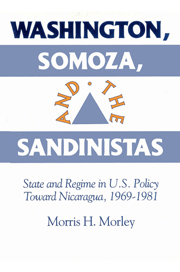Book contents
- Frontmatter
- Contents
- Acknowledgments
- 1 Introduction: Permanent and transitory interests in U.S. foreign policy
- 2 Washington and the Somoza dynasty: From consolidation to crisis of a client dictatorship
- 3 Supporting Somoza: Substance and symbol in American policy during the Nixon-Ford era
- 4 The Carter administration and Nicaragua: Human rights and the politics of accommodation
- 5 The Carter administration and Nicaragua: Mediation and the politics of frustration
- 6 Washington ruptures a historic relationship: Dumping the dictator to save the state
- 7 The Carter administration and revolutionary Nicaragua: Containing Sandinista power
- 8 Conclusion
- Bibliography
- Index
2 - Washington and the Somoza dynasty: From consolidation to crisis of a client dictatorship
Published online by Cambridge University Press: 31 March 2010
- Frontmatter
- Contents
- Acknowledgments
- 1 Introduction: Permanent and transitory interests in U.S. foreign policy
- 2 Washington and the Somoza dynasty: From consolidation to crisis of a client dictatorship
- 3 Supporting Somoza: Substance and symbol in American policy during the Nixon-Ford era
- 4 The Carter administration and Nicaragua: Human rights and the politics of accommodation
- 5 The Carter administration and Nicaragua: Mediation and the politics of frustration
- 6 Washington ruptures a historic relationship: Dumping the dictator to save the state
- 7 The Carter administration and revolutionary Nicaragua: Containing Sandinista power
- 8 Conclusion
- Bibliography
- Index
Summary
The historical setting of U.S.-Nicaraguan relations
Historically, Central America has been within the sphere of U.S. domination: frequent military invasions and occupations, economic and political interventions, and the routine manipulation of elected officials and army generals to suit overseas investor and strategic interests have been recurring themes in the twentieth-century relationship.
Starting in the late 1920s, Washington began the process of creating “national” armies in Central America and the Caribbean as the most costeffective, long-term alternative to repeatedly “sending in the marines” to put down nationalist challenges to client rulers and protect U.S. economic and financial interests. Since World War II, tens of thousands of army, naval, and air force officers from the sub-region have honed their fighting skills at American military training centers in the Panama Canal Zone or on the mainland. They have also received political indoctrination in the values (for example, anti-communism, anti-nationalism, open capitalist economies), ideals and belief systems of the dominant power. The Defense Department's role as the most important weapons supplier for the Central American military, the stationing of U.S. army, naval, and air force missions in these countries, bilateral military pacts, and periodic joint maneuvers further consolidated professional and personal relationships. The two most consequential outcomes have been sub-regional armed forces prepared to support the political and economic status quo (and, by extension, U.S. permanent interests), and Washington's determination to safeguard the power and prerogatives of these coercive institutions in periods of societal upheaval and political transition.
Prior to World War II, U.S. economic interests focused on the agroexport sectors while its geopolitical interests centered on the control and operation of the Panama Canal.
- Type
- Chapter
- Information
- Washington, Somoza and the SandinistasStage and Regime in US Policy toward Nicaragua 1969–1981, pp. 33 - 61Publisher: Cambridge University PressPrint publication year: 1994



